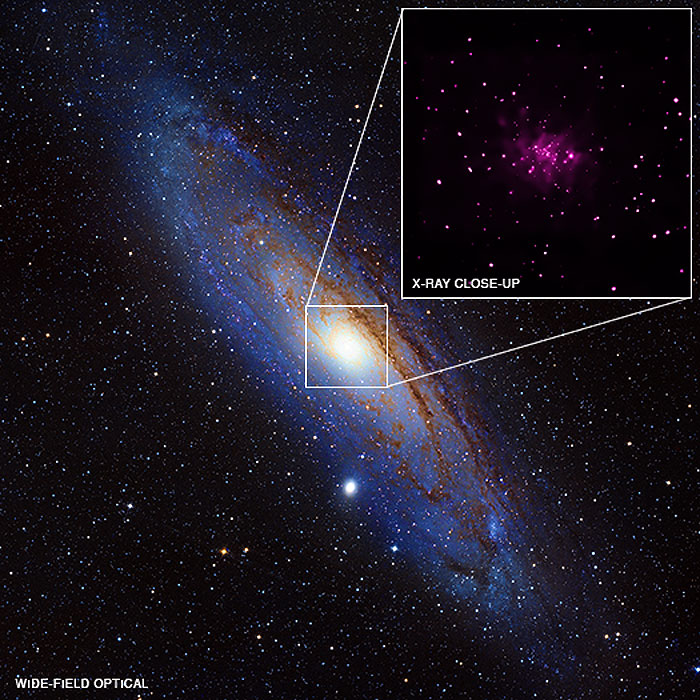.

Data from Chandra’s X-ray Observatory has led astronomers to unveil 26 black holes in the Milky Way’s neighbor, the Andromeda Galaxy. This is the largest number of black hole candidates found in a galaxy outside our own. Image Credit: X-ray: NASA/CXC/SAO/R. Barnard, Z. Lee et al.; Optical: NOAO/AURA/NSF/REU Program/B. Schoening, V. Harvey and Descubre Foundation/CAHA/OAUV/DSA/V. Peris.
.
Data from NASA’s Chandra X-Ray Observatory has led astronomers to unveil 26 black hole candidates in one of the Milky Way’s neighboring galaxies, the Andromeda Galaxy. The data was found using more than 150 Chandra observations over its lifetime of 13 years. The number of black hole candidates is the largest number to date in a galaxy other than our home galaxy. Nine black holes were previously identified from Chandra’s data; this new finding brings the total number to 35.
The black holes detected belong to the stellar mass category, meaning they were formed in the wake of dying stars. They typically have a mass five to 10 times larger than that of our Sun and can be detected as they pull material from companion stars and heat up, producing radiation (the black holes are otherwise invisible).
Astronomers had to make sure they were detecting stellar masses versus other galaxy systems’ super-massive black holes. Researchers utilized a new technique which drew on the brightness and variability of the X-ray sources in the data from Chandra. They found that the stellar masses changed more frequently than other systems’ black holes.
In addition, the researchers determined the X-ray sources had to have special characteristics, which include being brighter than a certain high level of X-rays and having a particular color. While neutron stars do not have these characteristics simultaneously, the black holes do.
The European Space Agency’s XMM-Neutron X-ray Observatory also supported researchers’ work by providing X-ray spectra (the distribution of X-rays with energy) for some of the black hole candidates, aiding object identification.
The results and findings from this research will be published in the Astrophysical Journal on Thursday, June 20. Many of the observations were found through Chandra’s Guaranteed Time Observer Program. NASA Marshall Spaceflight Center in Huntsville, Alabama manages the Chandra program for NASA’s Science Mission Directorate, located in Washington, D.C. Chandra’s science and flight observations are controlled from the Smithsonian Astrophysical Observatory located in Cambridge, Massachusetts.
The Chandra X-Ray Observatory is celebrating its 13th year of operation, having been deployed on STS-93 (a mission flown by space shuttle Columbia) on July 23, 1999.
Quelle: NASA
5974 Views
